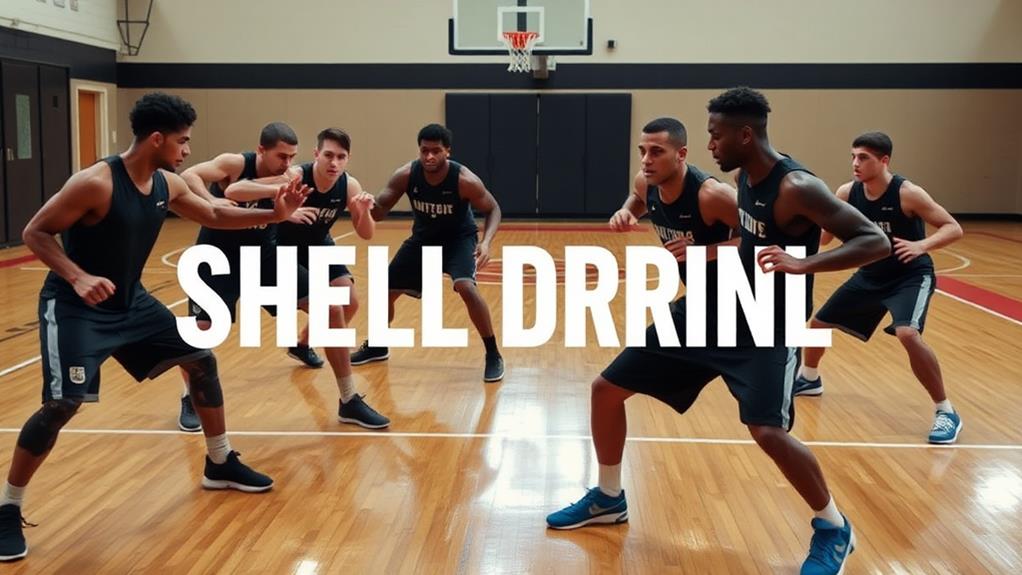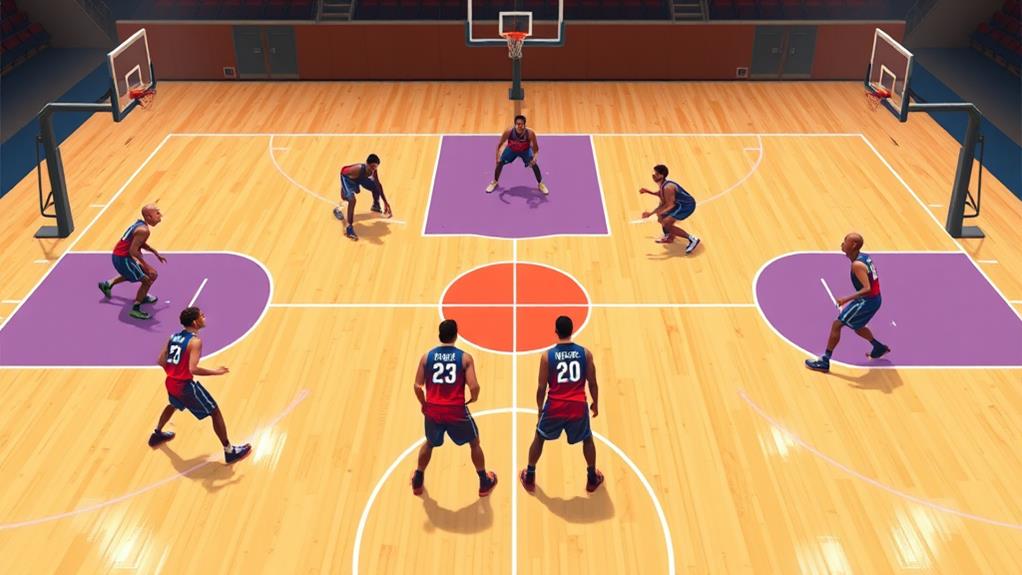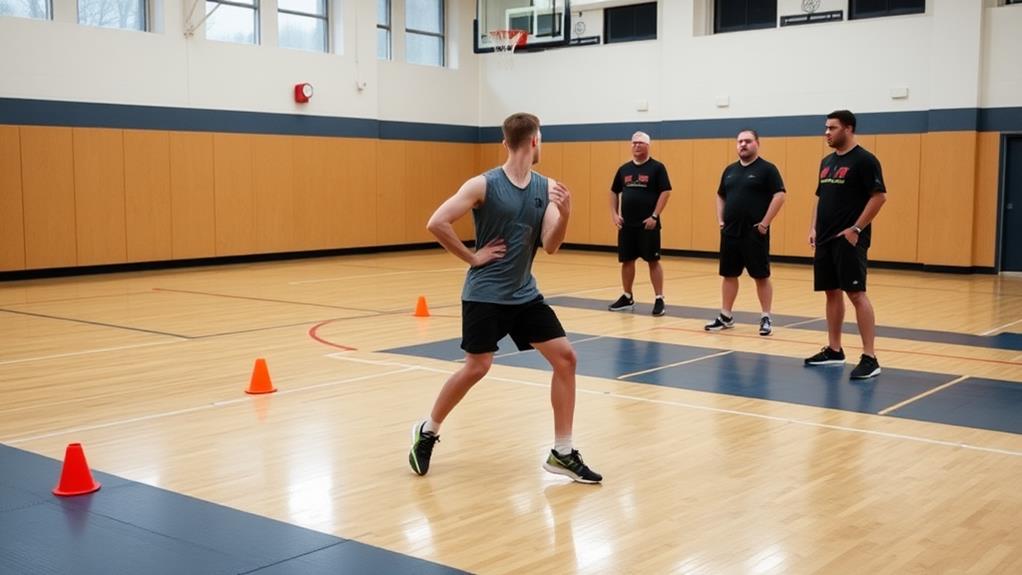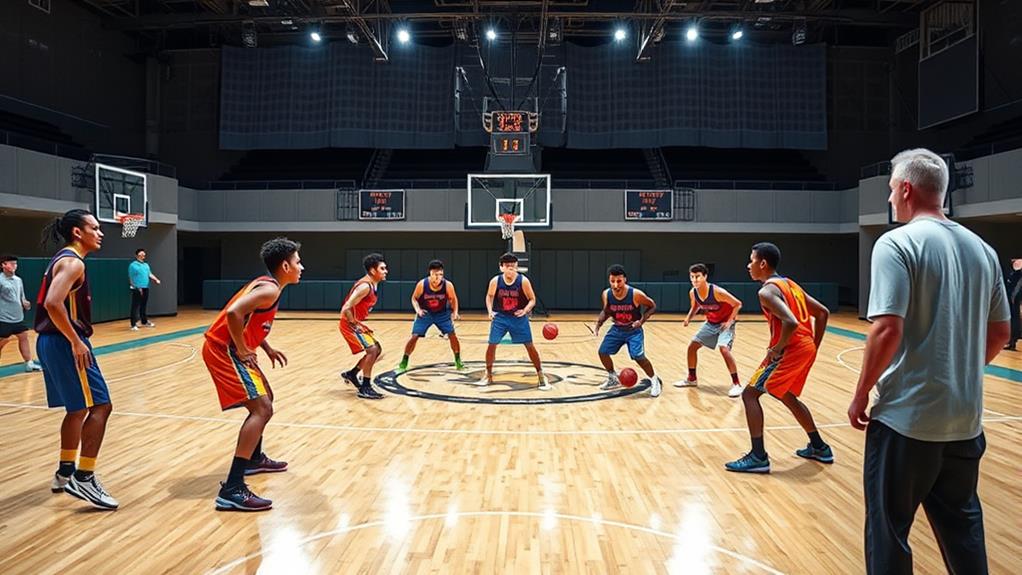
How to Run the Shell Drill for Defensive Mastery
October 6, 2024To run the Shell Drill effectively, start by positioning four offensive players around the three-point line and four defenders along the baseline. Assign each defender to an offensive player based on skill level. Emphasize communication; on-ball defenders apply pressure while off-ball defenders prepare for help-side support. Focus on mastering roles, such as maintaining hand presence one-pass away and executing timely close-outs. Begin with simpler formats, like 3-on-3, then progress to 5-on-5 to simulate game conditions. This drill builds defensive awareness, teamwork, and adaptability, essential for success on the court. Discover more effective techniques to enhance your training!
Overview of the Shell Drill
The shell drill is a foundational exercise that helps you and your team develop essential defensive skills. In basketball, this drill focuses on teaching team defense and proper positioning, emphasizing off-ball defense rather than just one-on-one matchups.
You'll typically see four offensive players positioned in an arc around the three-point line, which allows defenders to practice their awareness and collective contributions to defense. This drill mirrors concepts vital to soccer, such as effective marking and pressing, which create opportunities for counter-attacks.
As you engage in the shell drill, you'll learn key defensive principles like help side positioning, rotations, and closeouts. These concepts are vital for effective team defense, especially in fast-paced game situations.
This drill is particularly beneficial for youth players, as it instills foundational defensive principles and demonstrates the importance of teamwork. Coaches usually guide players through their roles and responsibilities before moving to live play.
This walkthrough helps reinforce the significance of communication and awareness on the court. By mastering the shell drill, you and your teammates will develop a stronger understanding of how to work together defensively, raising your overall performance when it counts during games.
Setting Up the Drill
To effectively run the shell drill, start by setting up the court to create a realistic game environment. Position four offensive players in an arc formation around the three-point line, with two at the top and two on the wings. This arrangement simulates game-like scenarios, allowing defenders to practice their positioning and reactions. Pair each offensive player with a matched defender based on skill level to guarantee balanced competition, fostering effective learning. Incorporating principles of pressure and cover will further enhance the drill, enabling defenders to anticipate offensive moves more effectively.
Next, set up four defenders along the baseline, keeping one coach at the top of the key. This coach will facilitate ball movement and provide instruction throughout the drill. Make certain that defenders understand their roles, especially the concept of help-side defense, to promote coordination and awareness during the exercise.
To enhance clarity during execution, utilize visual aids like cones or spot markers. These will designate specific positioning areas for both offensive and defensive players, helping everyone stay organized.
As you run the drill, emphasize the importance of communication among defenders, especially when they're one-pass away from the ball, to strengthen their overall defensive skills.
Roles and Responsibilities

In the shell drill, understanding your defensive assignments is essential.
You'll need to balance on-ball and help defense while staying aware of your teammates' positions. This is especially important during regular practice for team performance as it reinforces communication and teamwork on the field.
Clear communication will keep everyone aligned and ready to react as the ball moves.
Defensive Player Assignments
When executing the shell drill, each defender has an essential role shaped by their position relative to the ball. The on-ball defender applies pressure, while off-ball defenders position themselves for help-side support.
The defender who's one pass away should maintain a stance that allows them to intercept passes and be ready to assist the on-ball defender. This requires tight communication; they need to call out their assignments and alert teammates when they need help or when the ball shifts.
For two-passes-away defenders, the focus shifts to positioning themselves along the basket line. This helps provide coverage for potential drives or cuts from offensive players.
Understanding these defensive concepts is vital for maintaining team integrity. As you progress in skill, you'll take on more complex responsibilities, like switching assignments during rotations and recognizing offensive plays.
On-Ball Vs. Help Defense
While both on-ball and help defense are crucial for a cohesive defensive strategy, they each come with distinct roles and responsibilities that players must understand.
The on-ball defender's primary duty is to apply pressure on the offensive player with the ball, staying within three feet to contest shots and limit dribble penetration. This requires agility and focus, as they must react quickly to the offensive player's moves.
Help defenders, positioned strategically away from the ball, need to be ready to step in when the on-ball defender gets beaten. Their role involves protecting the basket or contesting drives effectively.
One-pass-away defenders should keep one hand in the passing lane, ready to intercept potential passes while maintaining awareness of their assigned offensive player.
Communication is crucial in this defensive setup. On-ball defenders must call out for help when needed, while help defenders should alert their teammates to potential threats.
Effective defensive rotations hinge on every player understanding their roles and responsibilities, ensuring coverage remains strong as the ball moves around the court. By mastering these roles, your team can enhance its overall defensive effectiveness.
Communication and Awareness
Effective communication and awareness are foundational to executing the shell drill successfully. As a player, you need to clearly understand your roles and responsibilities while engaging in real-time defensive scenarios. Calling out specific terms like "ball," "deny," and "help" is essential; it keeps everyone informed and maintains a strong sense of awareness on the court.
While tracking the ball's movement, you must also stay conscious of your matchup, requiring you to constantly scan the court for potential offensive actions. This dual focus will help you react quickly and effectively. Establishing clear expectations for on-ball and help-side defenders before you start fosters a cohesive understanding of defensive rotations and responsibilities.
Consistently reinforcing defensive terminology during the drill will aid in internalizing your roles, leading to improved coordination among players. The more you communicate and stay aware, the better your defensive execution will be.
Key Defensive Concepts
Mastering key defensive concepts is essential for any basketball player looking to enhance their game. Understanding the help side is significant; it allows you to support teammates while ensuring you're not too far from your assigned player.
When a player is one-pass away, you need to maintain proper positioning to prevent easy scoring opportunities. This positioning is critical for effective rotations, which help adjust assignments as the ball moves, ensuring support when on-ball defenders are beaten.
With the evolution of defensive strategies, effective positioning has become increasingly important as teams adapt to various offensive styles, reflecting the need for constant adjustments in today's game. Incorporating analytics for defensive schemes can also enhance your understanding of when to rotate or help, making your defensive efforts more strategic.
You must also know how to close out effectively. Rushing toward an open offensive player limits their shooting options, so timing and positioning are essential.
Remember, a well-timed close-out can disrupt an opponent's rhythm.
Lastly, strong communication is key. Use specific defensive terms to keep your teammates informed—calling out "ball," "deny," or "help" can make all the difference in maintaining awareness and executing strategies cohesively.
Progression of the Shell Drill

The progression of the shell drill ramps up as players gain confidence and understanding of defensive principles. You'll start with novice players focusing on basic defensive positioning, emphasizing the importance of maintaining balance and awareness. As their skills develop, you can introduce more complex scenarios, including dribble penetration and various offensive strategies, which can be informed by soccer moves guide.
Initially, conduct the drill in a controlled environment, allowing players to grasp key concepts like help side positioning and rotations. Once they feel comfortable, shift from simple 4-on-4 formats to full-court 5-on-5 applications, simulating real game situations. This game simulation helps players apply what they've learned under pressure.
As you advance the drill, consider adding variations that challenge players further. Introduce offensive actions like screens and cuts, prompting quick adaptations and strategic thinking. This keeps players engaged and reinforces their ability to respond to dynamic situations during a game.
Continuous feedback during these drills guarantees players effectively shift their skills from practice to competitive play, solidifying their understanding of defensive principles and enhancing their overall performance on the court.
Coaching Tips for Success
Successful coaching during the shell drill hinges on fostering a strong defensive mindset among players. To achieve this, emphasize the importance of player awareness. Encourage defenders to track both the ball and their assigned opponent, promoting a proactive approach to defense. Incorporating techniques such as a strong defensive stance can greatly enhance their effectiveness.
Establish clear communication by using defined defensive terms like "ball," "deny," and "help." This clarity helps players execute strategies effectively.
Incorporate visual aids such as spot markers and cones during your defensive drill. These tools enhance understanding of proper positioning and movement on the court. For young players, accountability is key; encourage them to actively point at the ball and their assignments. This practice cultivates awareness and responsibility in defensive play.
Throughout the drill, provide constructive feedback. It's crucial to help players grasp their responsibilities and improve their retention of defensive concepts. Reinforcing the significance of help side defense and proper positioning will solidify their learning experience.
Variations of the Shell Drill

When running the Shell Drill, you can adapt it to different formats like the 3-on-3, 4-on-4, and 5-on-5 versions.
Each variation serves a unique purpose, from focusing on individual skills in a smaller setting to simulating real-game scenarios with the full team.
Understanding the total players and team composition is essential for effectively utilizing these drills.
3-on-3 Shell Drill
Running the 3-on-3 Shell Drill allows players to focus on essential defensive skills in a dynamic environment. This variation emphasizes fundamental defensive principles while providing enough space for movement, making it ideal for younger or less experienced players.
As defenders, you'll need to quickly communicate and adjust your positioning to maintain coverage on offensive players, reinforcing the importance of teamwork and synergy.
In this drill, you'll practice help-side defense and closeouts in a manageable setting, allowing you to absorb key concepts without feeling overwhelmed. Coaches can adapt the drill to simulate specific scenarios, such as dribble penetration, enhancing your ability to react under pressure. This adaptability keeps the drill relevant and engaging, ensuring you're continually challenged.
To further support your learning, consider utilizing video resources that demonstrate effective execution of the 3-on-3 Shell Drill. Visual guidance can clarify concepts and improve your understanding of how to implement defensive strategies in real-game situations.
Embrace this drill as an essential tool for developing your defensive skills, fostering communication, and building a solid foundation for teamwork on the court.
4-on-4 Shell Drill
The 4-on-4 Shell Drill builds on the foundational principles established in the 3-on-3 format, offering a more expansive setting that emphasizes teamwork and communication among defenders.
This variation allows players to practice critical defensive principles in a more dynamic environment, focusing on team defense around the arc. You'll enhance your understanding of closeouts, help-side positioning, and rotations, which are essential in real-game scenarios.
Here are some key aspects to keep in mind while running the 4-on-4 Shell Drill:
- Encourage players to communicate effectively, calling out screens and switches.
- Focus on help-side defense to guarantee players know where to position themselves when a teammate gets beat.
- Practice quick rotations to reinforce the importance of support and recovery.
- Adjust spacing to challenge players, making the drill more intense as they improve.
- Utilize video resources to illustrate the drill, helping everyone grasp the nuances of team defense.
5-on-5 Shell Drill
Mastering defensive teamwork is essential in basketball, and the 5-on-5 Shell Drill is an effective way to build on the concepts introduced in smaller formats. This variation expands the principles of the 4-on-4 format to a full-court setting, allowing you to practice defensive rotations and help-side coverage in a more game-like environment.
In the 5-on-5 Shell Drill, you need to maintain awareness of both your assigned player and the ball, enhancing communication and teamwork during live play.
You'll emphasize closing out on shooters effectively, sprinting to contest shots while keeping balance and positioning. This drill challenges you to adapt your strategies based on offensive movements, reinforcing the critical concepts of help defense and ball denial.
Conclusion
To sum up, mastering the Shell Drill can greatly improve your team's defensive skills. Did you know that teams practicing the Shell Drill can increase their defensive efficiency by up to 20%? By consistently implementing this drill, you not only enhance individual player responsibilities but also foster better teamwork and communication on the court. So, get out there, run the Shell Drill, and watch your defensive game elevate to new heights!


